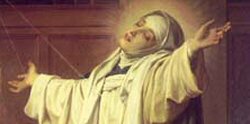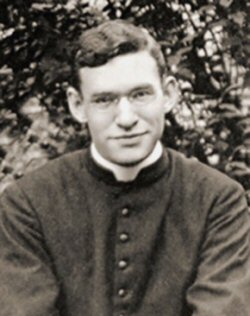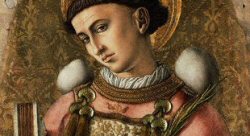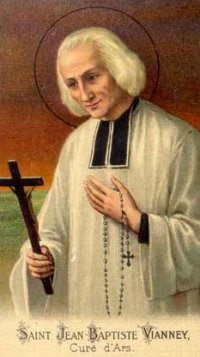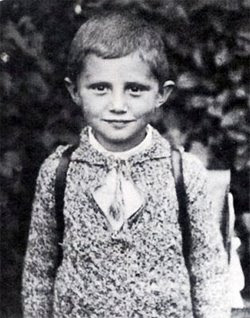Br. Simon Mary: Yes, absolutely.
NOR: Did you go to Catholic or public schools?Br. Simon Mary: I went to a public school in Cambridge.
NOR: Looking back, who were some of the early influences who helped in your religious formation?Br. Simon Mary: Apart from my mother and grandmother, I would definitely say the Augustinian Fathers. In Cambridge, when I was growing up, some priests from the Augustinian order staffed some of the parishes in rural New England. I first became aware of them at the Holy Sacrifice of the Mass and was blessed to have them for CCD classes as well, starting when I was six years old. These men were very impressive to me; they were men of deep prayer -- very disciplined, very devoted to our Lady. Their teachings were very orthodox.In my hometown, the population was roughly half Catholic and half Protestant, so to see these men in their black cassocks was a powerful witness to our Catholic faith. I realize now what a great visible witness they gave just by their presence.
NOR: Was there one person in particular whom you consider a significant early influence leading you to the religious life?
Br. Simon Mary: Yes. His name was Fr. Joseph Getz and, as you can imagine, he was one of the Augustinian Fathers. He married my parents, and he taught me and my brother how to serve at the altar during Holy Mass. What I remember most about him is his great devotion to the Blessed Mother -- Father always prayed the Rosary in the first pew before vesting for Mass. Watching him exercise his priestly office close-up during Mass was a very powerful experience for me as a young boy. His strong priestly character certainly demanded respect and admiration. He was a true spiritual father to me, and his reverence when saying Mass and his love for the Church and the Blessed Mother was inspiring.
NOR: With such an influence as Fr. Getz, did you entertain thoughts of becoming a priest?Br. Simon Mary: Yes. Many people -- family, friends, people at Mass -- would tell me or my parents after I served Mass that I should consider the priesthood, that I would make a good priest. I would say that this encouragement at the time made me think of one day perhaps becoming a priest.
NOR: What would you consider the earliest influence that led you to consider the monastic, rather than the priestly, life?Br. Simon Mary: That influence, coincidentally, was also Fr. Getz. As mentioned, I attended the public school in my hometown. The Augustinian Fathers would take us out of school during the middle of the day for catechism classes -- I can't fathom how they managed to do that, given the hostility of most public schools these days toward anything religious! In one of the CCD classes, when I was around nine years old, Fr. Getz showed us a children's video about St. Thérèse of Lisieux. This was my first encounter with the cloistered monastic life. I don't recall the details of the video, but only wondering, "What is this?" I had never heard of anybody voluntarily living such a life -- a life behind walls and grilles. I was definitely intrigued. I didn't pursue it at the time; it wasn't until much later that I came to realize who this great saint was. But here the seed was planted.
NOR: So there were really two seeds planted in your heart and mind: the priesthood and the monastic life. How did this play out in your early life?Br. Simon Mary: My hometown was part of the Diocese of Albany. At some point during my junior-high years, our parish became part of a "cluster" of three parishes that shared two diocesan priests. Ours was the parish without a regular priest. As part of this re-formation, the Augustinian Fathers were replaced by diocesan priests. When I found out that Fr. Getz would be leaving, I wrote him a letter. At the end of the letter I suggested to him that I too might become a priest.But when Fr. Getz and the Augustinians left town, that influence essentially left my life. Parish life changed drastically -- there wasn't the same strong Catholic identity or even the same activities for kids. I stopped serving at Mass. The priests who came from the surrounding parishes to say Mass were good men, but their presence wasn't as profound -- in part because they just weren't around very much.
NOR: So you entered your teenage years in a sense untethered from the profound influence of the Augustinian Fathers. How did your life change?Br. Simon Mary: I would characterize my teen years as very normal. I still attended Sunday Mass and took diocesan CCD classes, but that was pretty much the extent of my involvement in the parish. I did well academically in school, played sports, and joined in the usual activities. I had a lot of friends. Looking back, it was a great grace, being able to try out so many different things, to see what the world has to offer.
NOR: During this time, did you still have a sense of a calling to the religious life?
Br. Simon Mary: By my junior year in high school I started to feel a pull between the life of faith and the worldly life at school. I had the sense that maybe I was trying to "run away" from my vocation.
NOR: How did you respond to that pull?
Br. Simon Mary: Like a lot of people, I guess. I decided that maybe I just needed to get away. Get away from the small-town life.
NOR: Did you?
Br. Simon Mary: My folks were of modest means; there wasn't much opportunity for travel simply because there just wasn't money for it. One trip I do recall making was with my family on a pilgrimage to Our Lady of the Cape, a Marian shrine in Three Rivers, Quebec. I recall evening processions and a large convent of cloistered nuns on the shrine grounds. I remember asking my grandmother what they do in there. She replied, "They're praying for all of us." We went inside to hear the nuns chanting the Divine Office and I was captivated by what I saw through the screen: the traditional habits and veils. I remember thinking, "Wow, here's a group of cloistered nuns who never leave the building. They constantly offer prayers for the pilgrims." The power of prayer really hit home for me.But back to my junior year: My parents didn't have enough money for me to travel, so I applied for a scholarship to study abroad for a year in Germany as part of an exchange program between the U.S. Congress and the German Bundestag. The application process was grueling and involved six months worth of essays and interviews. There were thousands of applicants and I knew I would need a miracle to make it.On an inspiration of grace, I decided to pray the Rosary every day at the parish church on my way home from school, for the Virgin Mary's intercession for my scholarship application. I'll never forget one day -- one fateful day -- I prayed to the Blessed Mother, "If I can get this scholarship, I will maybe -- maybe -- think about becoming a priest again."
NOR: So you undertook some serious bargaining for this scholarship.
Br. Simon Mary: Indeed! But the prayer was so simple, so childlike. Yet I knew that I'd made a promise that I couldn't go back on.
NOR: What happened next?Br. Simon Mary: Here's where it gets really interesting. The next day, like every day, I went back to the parish church. There in the vestibule was a table with newsletters and magazines and the like that I'd never bothered to look at before. A certain magazine caught my eye called Vision that described all the different forms of religious life, all the religious orders and their charisms. At the bottom it read, "If interested, call us." Then it suddenly dawned on me: This was a sign from the Blessed Mother! "Oh no," I thought. "What have I gotten myself into?" I quickly stuffed the magazine into my backpack, thinking to myself, "Don't let anybody know about this!"
NOR: What did you do next?Br. Simon Mary: I took the magazine home, but I couldn't bring myself to look at it for a few days. Then, late one night, I finally got the courage to crack it open. I learned all about the different kinds of religious orders.
NOR: Did any particular one stand out?Br. Simon Mary: Yes, absolutely. The Carmelite order really captivated me: a life so completely consecrated, so completely given to God. I then recalled the video on St. Thérèse that I had seen so many years back in Fr. Getz's CCD class, and how fascinating the whole idea of the cloistered life was.
NOR: What happened with your scholarship?Br. Simon Mary: Wouldn't you know it, I got the scholarship! It was a complete miracle.
NOR: So now the cards are all on the table.Br. Simon Mary: Yes, and I began seriously contemplating the religious life. At the same time, I began receiving information from colleges and universities. And now I had a year in Germany ahead of me. My head was spinning; I didn't know what was going to happen.One particular episode sticks out from that time. I was invited to board with a Protestant family in Germany, but there was one catch: I had to go to a Protestant church with them every Sunday. I contacted them and asked if I could go to Mass. Maybe, was the reply, but not every Sunday, because I had to go with them to the Protestant church.
NOR: That's quite a dilemma for a young man discerning a vocation. What did you do?Br. Simon Mary: I wrote back saying that I wasn't willing to have them as my host family.
NOR: That took some guts! What was the reaction?
Br. Simon Mary: Let's just say it didn't go over very well! I upset a lot of people because the whole idea of the program was to foster understanding between the cultures. But there was no way I was going to miss Mass. By the grace of God, a devout Catholic family was finally found.
NOR: So here you are, now discerning a vocation, but preparing to ship off to Germany for a year.
Br. Simon Mary: It was an interesting time. I was visiting universities as well. I wrote around for information from a few different religious communities. I was looking for a community that had an intense contemplative life, with a devotion to St. Thérèse, and preferably with no exterior apostolate; the community had to be orthodox and faithful to the Magisterium. Through the Vision magazine I found a community of Franciscans in Boston, the Little Brothers of St. Francis, that had a strong life of prayer and a devotion to the Carmelite saints. We traded correspondence and I decided to visit them while looking at colleges in the area.
NOR: What did your family think about you corresponding with a contemplative religious community?
Br. Simon Mary: They didn't know! I was trying to keep it a secret. I didn't want any outside influence or pressure in any direction; I wasn't sure if my vocation was truly from God. But I'm sure they had some inkling of what was going on.
NOR: What about your friends -- did you tell any of them? Were there others you knew who were also contemplating the religious life?
Br. Simon Mary: I tried to keep it from everybody. None of my friends -- that I know of -- was discerning a vocation. But maybe they were trying to keep it a secret as well!But the attitude among my peers was pretty much to just prepare for college. College was really seen as the obvious "next step" in life by everybody I knew.
NOR: But first, for you, there was a trip abroad. Did your time away help or hinder your discernment?
Br. Simon Mary: I went with some trepidation, but my time in Germany was a wonderful experience. What's funny is that people there would ask me, "What are you going to do when you get back to the States?" My answer was, "Maybe I'll enter this Franciscan order in Boston." I really came to know there that I had a calling to the religious life.
NOR: When you got back, what was your sense of your calling?Br. Simon Mary: I knew that if I were to do this, I would want to do it whole and entire. It would have to be a radical departure from everyday life. If I am called, then why not try to live the life of the saints -- exteriorly and, more importantly, interiorly? But, ultimately, I only sought, begged, and prayed for God's will to become clear.
NOR: So now it's decision time: college or community? Or maybe both?Br. Simon Mary: I knew that, because my parents were poor, going to college would entail great cost and student loans and heavy debt. I realized that this would only delay my entering the religious life, possibly for years, if not forever.
NOR: Did you pursue the Franciscans in Boston?Br. Simon Mary: I did. After visiting and talking with the Superior, I decided to join the community on probationary terms, first as an observer (a three-month period), followed by postulancy (a six-month period). What appealed to me was that they were not ashamed to be religious. They wore their habits at all times. When they went out to minister to the poor on the streets of Boston, they were a visible witness to the religious life and Holy Mother Church in a very secular place.In their spare time, the friars would often visit a cloistered monastery of discalced Carmelite nuns nearby. I was asked to serve at Holy Mass on the Feast of St. Thérèse at the convent. Again, I found myself intrigued by their life. It kept hitting me that all our work with the poor would bear no fruit if it weren't for the constant prayers of these cloistered nuns. The Franciscans have a very strong prayer life, but when it was time to go out among the poor, I found myself always wanting to stay behind to pray, to "practice the presence of God," as Br. Lawrence of the Resurrection put it. Br. Lawrence was an influential figure for me; here was a discalced Carmelite who was also a man. Then it dawned on me that that was what I longed for: A cloistered Carmelite community for men. The only problem was that there was none that I knew of.
NOR: So you came to realize that the Franciscan community was not for you.
Br. Simon Mary: Yes. It was a very sad, very painful decision to leave the Franciscan community. Many prayers and many tears accompanied my decision.
NOR: Once you left Boston, what did you do? What was your state of mind?Br. Simon Mary: Well, my family was happy to have me home again. But for me it was really a time of confusion. I thought that since the Franciscan experience didn't work out, perhaps I was called to the married state. I really didn't know what was going to happen to me or what I should do. I knew the Lord had put a desire in my heart for the cloistered Carmelite life, but to my knowledge there was no such community in the entire world.
NOR: What did you end up doing?
Br. Simon Mary: I ended up, of all things, as a paralegal in Vermont, working under an attorney and studying to take the state bar exam. I worked there for a year and a half, living in an apartment in a country farmhouse.
NOR: How did you like that work?Br. Simon Mary: The attorney was a kind man, and took me under his wing like a son. But I found that when I went to bed at night, I was very unsatisfied. The religious life was constantly on my mind. It soon became very obvious to me -- and I'm sure to everyone around me -- that I had a calling to the contemplative life. While doing some research, I came across an order of Carmelite hermits in Christoval, Texas. I had earned one week of vacation at my job, so I decided to go to Texas to visit.
NOR: Did you like what you saw?Br. Simon Mary: As I told the prior, Fr. Fabian Maria, "I love your life, but I'm not called to be a hermit." I had finally found a community of Carmelite men living a cloistered way of life, but I knew that I was not ready for the solitude required of a hermit. I asked the Prior if there were any monasteries in the discalced Carmelite tradition for men. He said there weren't -- our monastery in Wyoming hadn't been founded yet. At the end of my retreat, the question remained: "Where can I find a monastic, manly way of life in community with all the devotions of the Carmelites?"
NOR: Did you find that community?Br. Simon Mary: Amazingly, I did. I was looking on the Internet one day and I googled "new Carmelite monks." An article from the Casper Star-Tribune came up that reported on a new, strictly cloistered monastic community in rural Wyoming. I stopped reading and said, "Wait! That's the life of St. Thérèse!"
NOR: That sounds like a shot out of the blue.Br. Simon Mary: It sure was. It's funny to think that you can find your calling to a cloistered community on the Internet. So I talked to my spiritual director, a young, humble priest of the Congregation of the Holy Cross in Vermont, who suggested I write to the Father Prior in Wyoming, which I did.It was a long, long time before I heard back. I had made the mistake writing just before the Easter Triduum -- a very busy time at the monastery! In his letter, Father Prior explained to me quite clearly what life at the Carmel in Wyoming was like. He explained that the monks always wear the traditional habits, are faithful to the Pope and the Magisterium of the Church and will have nothing to do with theological dissent, and that they only celebrate the Traditional liturgy.
NOR: What was your reaction to that?Br. Simon Mary: Well, the part about their habits and faithfulness to the Magisterium was everything that I sought. But I'd never been to a Traditional Mass before. But it was easy for me to see that a Carmel with the traditions, customs, and discipline of the saints would also need the reverence, beauty, and awe of the Traditional Mass if it were to endure. Plus, the Carmelite Rite has the approval of the local Ordinary, Bishop David Ricken of Cheyenne, who founded our monastery in 2003.
NOR: So your vocation was really nurtured in the New Mass?
Br. Simon Mary: Yes, thanks to the very reverent and beautiful liturgies celebrated by the Augustinian Fathers in my hometown.
NOR: But now you are part of an order that celebrates the Traditional Mass.Br. Simon Mary: Yes, but a distinction must be made: We celebrate the traditional Carmelite Rite of the Mass, which is very similar to, but distinct from, the Tridentine Mass. In the great tradition and richness of the Church, many ancient religious orders were honored to have their own distinct rites of the Mass. The Carmelite Rite is the great inheritance of a Carmelite, being imbued with so many feasts, chants, and rubrics proper to the spirituality of Carmel. Our community is dedicated whole and entire to preserving the fullness of the Carmelite liturgical life -- the Carmelite Rite is at the very core of our monastic existence and gives life and strength to our ancient and venerable tradition.
NOR: Tell us about the charisms of your monastic community.Br. Simon Mary: Carmelite monks are consecrated to God through the vows of obedience, chastity, and poverty. Our time is spent in prayer and penance for the salvation of souls, interceding for the Church and the world, as well as in the study of Scripture and the fathers and doctors of the Church.Our Carmelite community has four pillars: The first is filial devotion to the Blessed Mother. Second is the Holy Rule of St. Albert, also known as the Carmelite Rule, in its original observance. Third is the Carmelite Rite of the Mass, the liturgy in use until the Second Vatican Council. And fourth, the discalced Carmelite charism: the spirituality, customs, and way of life as lived by St. John of the Cross and St. Theresa of Ávila, which entails a strict constitutional enclosure -- our monks don't leave the monastery at all, except for doctor appointments when no doctor is available to come to the monastery, or other emergencies, with permission from the Bishop.The structure and discipline of the Carmelite Rule protects our monks from modern, worldly temptations. That protection is very important -- you can't allow new things in, because then discipline breaks down. Modesty and chastity must be protected and our Carmelite way of life preserved for the young men who come after us. There is structure and objectivity to our life. The rules are kept closely; there's no guess work about what we're supposed to be doing. We strive to do what the saints have always done. The goal of our Carmel is to transform men into saints -- and not just our monks, but all the men united with our monastery. The Carmelite life is at once ancient and new. Nuns have had it for a long time, but it's new for men. The word "Carmel" means "the garden of God" in Hebrew. Here we know the power and beauty of living outside of time, living our lives completely for the sake of Jesus and Mary.
NOR: One could easily get the impression that cloistered monks are so far removed from the world that they have no concept of current events and the challenges facing the Church in the modern world, and that therefore their prayers can't be directed to specific problems. Is this true?Br. Simon Mary: No. We get news of the outside world from visits and correspondence with our family, friends, and benefactors. We have a good idea of what's going on in the world, but we're spared the gory details. As far as current events, the sins of the world aren't new.
NOR: Are you allowed to read newspapers and magazines?Br. Simon Mary: Yes. We are allowed orthodox Catholic publications in our library. But Father Prior looks over all material that comes in, to make sure that there is nothing that would offend against modesty and chastity. Our library also stocks a wonderful array of works by the Doctors of the Church and on the lives of the saints.
NOR: How does the monastery survive in such a remote area?Br. Simon Mary: Wyoming is only marginally Catholic, so we need to be self-supporting. We follow the dictum of St. Paul: He who doesn't work shall not eat. One of the hallmarks of the monastery is manliness: we work with our hands, doing our own maintenance and upkeep of the building and the grounds. In the monastic tradition of small cottage communities, we roast Mystic Monk Coffee here at the monastery. [See the advertisement on p. 15 of this issue -- Ed.] Aside from that, we are dependent on alms. Our monastery was founded on the principle of poverty.
NOR: How do you get food to eat?
Br. Simon Mary: Obviously, we can't go to the store and buy groceries. Most of our food comes from our neighbors in the area who donate food to us as acts of charity. By the grace of God, we have never gone hungry! But we hope in the future to have some farmland within the monastery grounds, and a milk cow and some chickens.
NOR: What is your daily life like?
Br. Simon Mary: Most of our day is spent in prayer. We pray the entire Divine Office, which consists of eight canonical hours of prayer, starting at 4:10 in the morning. We spend two hours in mental prayer each day, one hour in the chapel and one hour in our cells in solitude. Two hours are given over to contemplative prayer. And, of course, we pray the Holy Sacrifice of the Mass each day.The rest of our time is taken up with daily labor. We have a brother cook, a brother cobbler, a brother tailor, and so on. There are household chores to be done, cooking, correspondence, answering the phone, etc.We are also allowed one hour of recreation each day. This is an extremely joyful time to relax as a community, share a good laugh, or get some exercise -- we'll get a football game going, or hike around the monastery grounds. I would say that monastic joy and fraternal charity are hallmarks of our community.
NOR: Do you observe a vow of silence?
Br. Simon Mary: No, but we refrain from unnecessary conversation outside of recreation, preferring rather to foster that interior conversation between the soul and God.
NOR: Was the lack of ongoing conversation a big adjustment for you?
Br. Simon Mary: Yes, but by fostering an interior life, one practices the presence of God. Prayer becomes more interior, more silent. Prayer really involves many acts of the will, not many words. In the contemplative life we don't get to see the visible fruits of our labors; those fruits are given over to God in prayer.
NOR: What were the hardest adjustments you had to make?Br. Simon Mary: There were a few adjustments, but none was insurmountable. From the outside, one might say oh, there's no TV, no radio, none of those modern conveniences. But I really don't miss them. Probably the biggest adjustment was my unfamiliarity with the Carmelite way of life -- it's at the same time ancient yet unknown. It hasn't been widely studied or promoted in our times.I'd say the hardest thing here is that as a contemplative monk, you are constantly faced with yourself -- your humanness, your sinfulness, your struggles and failures to grow in the imitation of Christ. In the world there are so many distractions --TV, radio, and computer, for instance -- but here you are confronted with yourself, you find yourself, see who you truly are. And only by seeing our weaknesses can we make progress in the spiritual life. The monastic life is so completely contrary to modern life.
NOR: Are visitors allowed?Br. Simon Mary: In the Carmelite tradition, we welcome visitors who come to the monastery each day during visiting hours. For the monks whose families are local, they are allowed visits once a month. For the rest, we are allowed phone calls and letters once a month. My family comes out about two times a year.
NOR: Do you miss your family?Br. Simon Mary: You know, joining a monastery is easier for the monk than for his family. When I announced that I was joining the Carmelite Order, my family struggled deeply with my vocation to the contemplative life. But they have since found consolation in the prayers of the monastery.
NOR: What would you say to those who think that the monastic life is "boring"?Br. Simon Mary: Life here is anything but boring! Life as a monk is filled with great peace and joy. Here we are in the ante-chamber of Heaven -- our lives are given over completely to the love of God. The life of a monk is a life of great peace.When I left New England, some of my extended family members said, "Oh, he's dead to us now." But our life here is a life of such great joy. It's not boring or like a prison at all. Here one comes to understand that the power of prayer opens up channels of grace for the active members of the Church's apostolates. The religious life is so different from people's preconceived notions of old, lonely men wandering in solitude around empty halls. All the monks here are in their twenties and thirties. It's a vibrant community.
NOR: Where are you in the process of your vocation?Br. Simon Mary: I have professed temporary vows. The first year in the order is called the postulancy. That's followed by a two-year novitiate. And then temporary vows are professed for a period of three years. Finally, perpetual vows are professed, and those are for life. I have two years left before I profess perpetual vows.
NOR: How many monks are there at the monastery?
Br. Simon Mary: There are ten of us now. There are an additional forty men who are in the process of discernment. Discernment is a very strict process. We are very strict about not allowing in any homosexuals or drug or alcohol abusers, only men who are truly dedicated to serving Holy Mother Church. By year's end, it seems we will have between fifteen and twenty monks.
NOR: Such growth is almost unheard of these days. Can the monastery accommodate all these young men?Br. Simon Mary: We have been blessed by rapid growth, but we are in great need of housing for these exceptional young men. Our monastery has located an ideal, remote setting on 500 acres in Wyoming's Rockies, where our life might be taken up in the fullness of its splendor and power. This property would allow us to realize our vision of strict enclosure and the fullness of the eremitical life. In God's Providence, this mountain setting already has an existing lodge, guesthouse, and caretaker's house, which are suitable for our immediate growth and would allow us to start offering retreats. All the same, our monastery is truly founded in poverty and in need of a miracle if this property, known as Irma Lake, is to be secured as the New Mount Carmel here in the U.S. We must find individuals capable of helping us acquire this setting for the honor of the Immaculate Mother and the glory of Almighty God. Please pray for God's blessing in this time of great necessity. As monks, we humbly place our trust in the Infant of Prague, the Virgin Mother, and our good father, St. Joseph.
NOR: What advice would you give to a young man who's considering the religious life?
Br. Simon Mary: For the young man -- for everybody, really -- it is important to develop a prayer life. Without prayer and the reception of the Sacraments, discernment is just not possible. You must develop a love for the saints, especially the Blessed Mother. Without devotion to the Blessed Mother, you won't make it. The Blessed Mother leads us to Christ.It's also important to have an orthodox spiritual director to whom you can confide your soul. He can help you properly discern the events and the course of your life.But the best advice I can give someone is to be bold. Don't accept the status quo in life; don't presume that going to college is the obvious next step after high school just because everybody else is doing it. Don't presume that you are automatically called to the married state just because all those around you have taken it for granted. Start instead by thinking that God might be calling you to be completely consecrated to Him, and that you were made for His glory. The first priority in your life should be to do God's will, and to do that you must discern His will in your life. Just think: What will I have lost by trying out the religious life for just one year? We are living in difficult times; now is the time to become great saints.
NOR: But how does one develop a prayer life when most young people have received such poor catechesis?
Br. Simon Mary: Start by praying the Rosary. It's easy to learn and easy to pray. Meditating on the mysteries of the Rosary opens up one's heart to God. Pray the Chaplet of Divine Mercy. Spend time in Eucharist Adoration. These profound acts of prayer don't require great learning or in-depth instruction. But to really develop a potent prayer life, you must first root out sin from your life. Not coincidentally, prayer is one of the best aids in doing that. Also, it's important to read the lives of the saints. Anybody can do this. You will become a witness to their heroic virtues. You will see the simple ways they approach God and bare their souls to Him.I can't stress enough, though, how vital a prayer life is. It helps us grow in our relationship with God. He's there waiting for us; He will help us reach Him, if we are willing. We are all -- each one of us -- called to union with God.
NOR: Any final thoughts?Br. Simon Mary: The contemplative life is necessary for the strength and well-being of the Church. This must be understood by all Catholics, especially the young. The Church's timeless teaching on prayer is really gone now, replaced by such oddities as centering prayer and yoga. These are not traditional; these don't build up the Church. The life of prayer must be instilled in the home, because -- and this is the thought I'd like to leave you with -- without prayer we can do nothing.
NOR: Thank you, Brother Simon Mary, for sharing your insights and your story with us.Br. Simon Mary: At your service. May Our Lady of Mount Carmel lead your readers ever nearer to her Divine Son and protect them under her pure white mantle of maternal tenderness. Your readers are certainly in our prayers as together we work for Christ and His Holy Church.
+ + +
Those interested in learning more about the Carmel of the Immaculate Heart of Mary may write to: Carmelite Monastery, 35 Road AFW, Powell WY 82435, or phone: 307-645-3310. The monastery can be found on the Internet at
www.carmelitemonks.org[The forgoing article was originally published as a New Oxford Note, "An Interview With a Carmelite,"
New Oxford Review (July-August, 2008), and is reproduced here on Roman Catholic Vocations by kind permission of New Oxford Review, 1069 Kains Ave., Berkeley, CA 94706.]
 From the St. Louis Review Online
From the St. Louis Review Online















